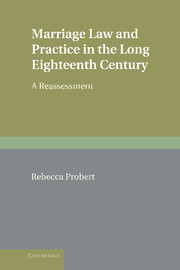Book contents
- Frontmatter
- Contents
- Preface
- 1 Introduction
- 2 The misunderstood contract per verba de praesenti
- 3 The myths of ‘informal’ and ‘common-law’ marriage
- 4 The little-considered marriage practices of non-Anglicans
- 5 The unacknowledged regularity of clandestine marriages
- 6 The eventual passage and actual terms of the 1753 Act
- 7 The unappreciated success of the 1753 Act
- 8 The unexplored judicial interpretation of the 1753 Act
- 9 The overlooked response of non-Anglicans
- 10 Conclusion
- Index
- References
6 - The eventual passage and actual terms of the 1753 Act
Published online by Cambridge University Press: 10 February 2010
- Frontmatter
- Contents
- Preface
- 1 Introduction
- 2 The misunderstood contract per verba de praesenti
- 3 The myths of ‘informal’ and ‘common-law’ marriage
- 4 The little-considered marriage practices of non-Anglicans
- 5 The unacknowledged regularity of clandestine marriages
- 6 The eventual passage and actual terms of the 1753 Act
- 7 The unappreciated success of the 1753 Act
- 8 The unexplored judicial interpretation of the 1753 Act
- 9 The overlooked response of non-Anglicans
- 10 Conclusion
- Index
- References
Summary
So far, it has been shown that contracts per verba de praesenti were neither a full nor a functional alternative to regular marriage; that most non-Anglicans married in the Church of England rather than according to their own religious rites; and that although clandestine marriages were common, most differed little from regular marriages. Given this evidence of regularity, the reader may well wonder why legislation was needed at all. But of course some types of clandestine marriage were highly problematic. The previous chapter focused on the problems posed by clandestine marriages for the parties themselves – in terms of proof and potential punishment – but there was a further dimension that was more likely to interest the propertied men who made up Parliament, namely the possibility of their minor children marrying without their consent or knowledge. This, and other problematic aspects of clandestine marriages, is considered in the first part of this chapter.
The fact that clandestine marriages were problematic may indicate why reform was necessary but does not explain the timing of the reform. After all, clandestine marriages were hardly a novel problem in 1753. Nor was the Bill introduced in that year the first to try to address the problem. The second section examines the various theories that have been advanced to explain the passage of the 1753 Act, and puts forward a rather simpler explanation that takes account of other contemporary reforms.
- Type
- Chapter
- Information
- Marriage Law and Practice in the Long Eighteenth CenturyA Reassessment, pp. 206 - 243Publisher: Cambridge University PressPrint publication year: 2009

